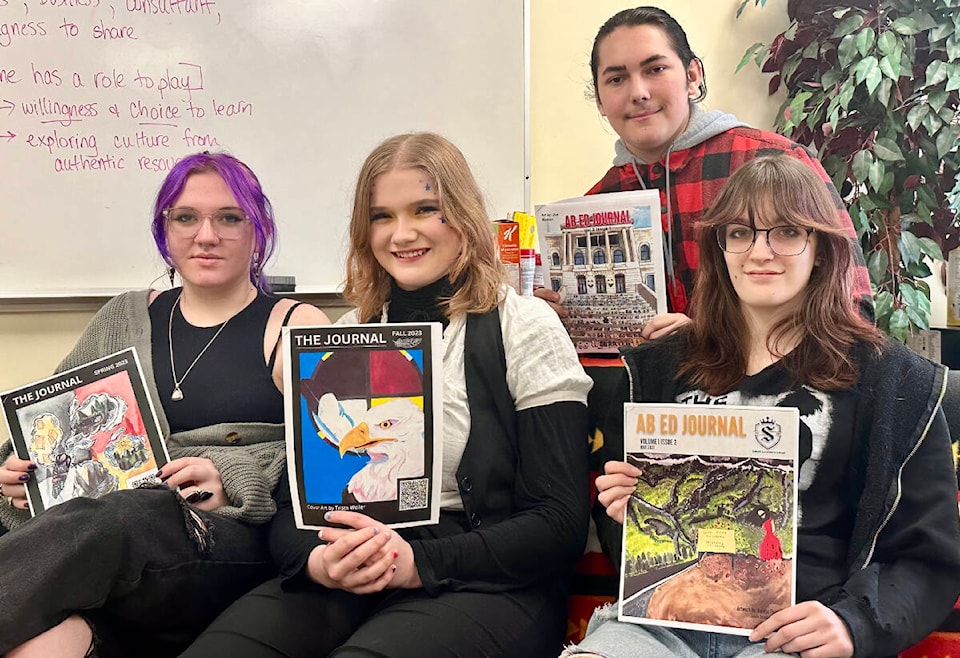In spring of 2022, the Kimberley Bulletin went to sit down with Selkirk Secondary’s Indigenous Education students to learn about their magazine they created to highlight the issues of a modern Indigenous Canadian through numerous articles and pieces of art.
The Bulletin was invited back this year to meet with a new class of students and hear about what has been happening with The Journal, as it’s been rebranded, since the last visit.
The class is headed by educators Esther Sylvestre and Amy McInnis. Not all students in the Indigenous Education program were present, but the Bulletin had the opportunity to meet with McInnis as well as students Ash Odnokon, Ren Neville, Seth Strauss and Ruby Schultz.
READ MORE: Selkirk Aboriginal Education students create Ab Ed Journal publication
Odnokon is in Grade 10 and is the current main editor of The Journal, in addition to producing a variety of articles for it.
“I think Esther told me about it and showed me the past journals and I thought it was really interesting and I like being a part of it, to share information with other people about these topics,” she said.
Neville had helped with editing a few issues back, but for this coming spring edition has been focused a lot more on writing. Neville has a passion for botany, and has been writing about the subject a lot recently, including focusing on the traditional medicinal uses for plants and their Ktunaxa names.
“That’s one that’s really interesting to people because they’re like it’s short, it’s sweet, it’s easy to digest, that type of thing and it’s just interesting enough that it catches someone’s eye,” Neville said. “I definitely feel really proud whenever I get to write about this.”
Seth Strauss, a Grade 11 student, is writing his first article ever for the magazine for the coming edition, focused on his experience with joining the Cadets over the past five months.
Schultz is in Grade 9 and has created the art work for the past two editions in addition to suppling a variety of articles.
“I think it’s really cool because, I know a lot of artists, we have Centre 64 where we get to sell our art, but we get an opportunity, especially with the people before me as well, the opportunity to publicize our art and then also even writing in it still I think is an amazing thing and it’s an amazing thing to see it,” Schultz said.
Schultz also recently wrote a book report discussing Mary Summer Rain’s Spirit Song, a book that she said was one of the first major introductions to learning about Indigenous culture.
“A few people I know have read that book and they were really happy to see it get credit because, it is such an old book,” Schultz said.
Schultz said she was steered towards the Indigenous Ed. program and The Journal when, in her last year at McKim, she and some other students painted a mural in the school’s library of the Indigenous creation story.
“A few of the teachers gave word to Esther and Amy about the art that I did and how I was into learning about the Indigenous side of my family,” Schultz said.
“Esther talked to me about doing the cover for the Journal, for the last one I mainly wrote for it but now I’m back to doing the cover for it. The reason I like it is again the connection, but it also because it was my first year in high school it was a great eye opener and helped me transition a lot more.”
Juggling the responsibilities of publishing the magazine while doing a full high-school course load can be a lot of work, which is why the decision was made this year to make two issues in the school year.
Publishing articles can also be a really nerve-wracking experience — it is a daunting putting out articles or artwork with your name on them, but the students also find it to be very rewarding.
“I think it’s nice to see your own article and I think it’s nice to see it in a physical copy, because we do it all online, so seeing it physically is really nice, but I’m personally always more excited to see what everyone else has done,” Odnokon said.
“Apart from editing, we aren’t seeing each other’s work too much. We know each other’s ideas but we don’t really know the final project. Especially because usually on the last day everyone throws in some extra edits here and there.
“And so it’s kind of nice seeing how everything flows together and how it’s all connected and how the themes move throughout the whole thing. I definitely getting to look through other people’s articles and being like ‘oh yeah they talked about that, that looks awesome on paper.’”
This project not only allows these students the chance to learn more about Indigenous culture, and in some cases, connect with their own Indigenous heritages, it is teaching them a wide range of skills they can perhaps integrate into future educational or professional endeavours.
